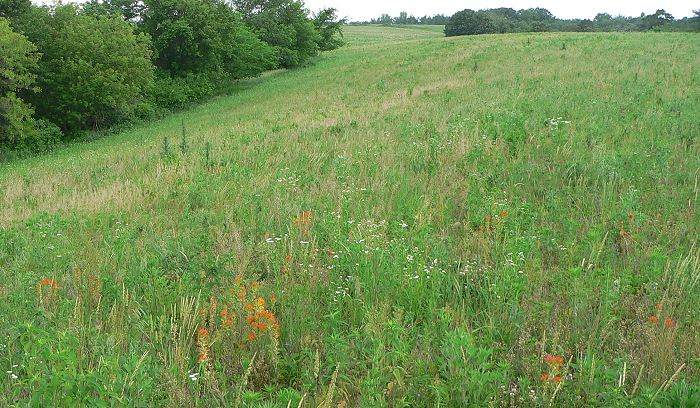This was a big Cecropia week – now almost all of the moths have hatched, so I’ll get a break from getting up at dawn to mate them. Here’s the full story of the Cecropias.
We also did some work in the wetland and gave a short tour of the farm.
The tour was for some wildlife managers and folks from county boards from all over Wisconsin. They were at a meeting in Buffalo County, and went on a tour of some local spots. It was fun for us to be a stop on the tour. We got to show off the farm – just a quick tour of one prairie.

And we got to talk to a bunch of nice folks about the restoration work we’re doing. I hope they come back sometime to get a longer tour.
Wild Parsnip, which has invaded large areas of the wetland, started blooming this week. It’s a nasty invader, which spreads very quickly and crowds out native species. It also causes a bad skin reaction if you get the juice on your skin and then are exposed to sunlight.

We’ve been trying to get rid of the Parsnip in one of our big wetland meadows. The meadow is a couple acres in size, so it’s too big to weed by hand. Mowing just before the plants flower doesn’t eliminate the Parsnip, but it seems to reduce the population. A couple years ago I sprayed and replanted wetland species in the eastern part of the meadow, along the driveway. So this week I hand weeded all the Wild Parsnip from that area while Mike mowed the rest.

Wild Parsnip has huge roots.

The bigger and more branched they are, the harder they are to pull out. If I can’t pull them, I cut them as far under the ground as I can so they won’t resprout.
I liked this picture too – each root has such personality.

Here’s the mowed meadow from the road.

There are more butterflies on the driveway every week – this week most of them were Silvery Checkerspots. This group is mostly Silvery Checkerspots with a few Pearl/Northern Crescents.

These are Great Spangled Fritillaries with a few Silvery Checkerspots.

Mike got a new camera this week, so some of these photos are his. He likes taking pictures of other people taking pictures – so here I am.

The camera is small enough that he can carry it with him all the time. For such a small camera, it takes very good photos, and even good close-ups. Here’s a photo of a Baltimore Checkerspot taken with the new camera.

Buffalo Ridge Prairie is looking good now that the flowers are starting to bloom. (This is its second summer.) Here’s a view down the prairie with Indian Paintbrush in bloom.

And a couple more close-ups of the prairie plants.
Indian Paintbrush, Junegrass and Prairie Brome

Prairie Phlox and Monarda

The aspens that I’ve girdled are starting to die, so there will be some logging projects to do soon. Here are two big clones along the edge of 3 Finger Valley.

And another one on top of Indian Grass Point.

When the aspens die the plants on the ground get a lot more light. Hopefully that will help the prairie plants come back even before we get the trees cut.
These are a few of the new flowers blooming this week.
White Camas (Zigadenus elegans)

and a close-up

Frostweed (Helianthemum bicknellii)

Purple Milkwort (Polygala polygama) – these look like tiny orchid flowers

Spiked Lobelia (Lobelia spicata)

White Wild Indigo (Baptisia alba) This has actually been blooming for a few weeks, but I love the way it looks and I keep finding new big clumps of blossoms.

Here’s a monarch caterpillar on Butterfly Weed

And a Northern Pearly-eye.

A Gray Comma sat next to me on the other seat of the gator – calmly sipping sweat from the surface of the seat.

Here’s the underside of its wings with the comma mark.

One of my chrysalises hatched (I collected the caterpillars last week from some sunflower leaves along one of the farm roads) – it turned out to be a Silvery Checkerspot. Here it is drying its wings with the used chrysalis behind it.

And here it is from the top, just before it flew away.

I zoomed in on one of the photos Mike took and could even see the tiny scales that cover the surface of the butterfly’s wings.

I saw several of these bright yellow moths flying in the woods. They are False Crocus Geometer Moths (Xanthotype urticaria)

